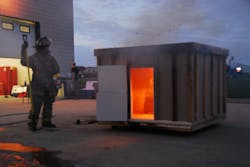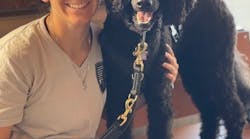Greg Gorbett spends unmeasured hours building scale-model rooms, complete with furniture and fixtures. He then judiciously stacks wood cribbing inside and burns his creations. More often than not, he generates a fairly rare fire phenomenon called backdraft. Unlike the 1991 movie of the same name, Gorbett’s creations bellow soot-filled fireballs from inside high-temperature spaces that do not lend themselves well to moviemaking.
Gorbett, an assistant professor in fire and safety engineering technology at Eastern Kentucky University (EKU), also has experience working as a private consultant in fire, arson and explosion investigation. He specializes in fire behavior and fire dynamics. Gorbett and Jim Pharr, also an assistant professor in fire and safety engineering technology at EKU, said they have learned much about the phenomena of flameover, flashover and backdraft while firing the imaginations of students and colleagues alike.
Misconceptions
Gorbett’s interest in backdraft started when he was researching other fire phenomena while working for a fire investigation firm. He said he became enamored with historical discussions of backdraft and how they related to an up-to-date look of the phenomenon.
“I found there was not much science concerning backdraft,” he said. “The foundation was set by (researchers C.M) Fleishman and (P.J.) Pagni in 1993. Others have studied this phenomenon, but there are still some misconceptions out there. For example, some of the warning signs of backdrafts, which are based on firefighter common knowledge, tend to be on track. One of the items, a whistling sound, indicating an intended backdraft, might be a myth. We have not been able to replicate it.”
Others, such as a firefighter using a pike pole to break a window allowing air to rush inside a burning building and cause it to rapidly explode, are erroneous, he said.
“We have found in our quarter-scale-compartment burns that it can take up to 30 seconds for backdraft to occur,” he said. “So it’s not hard to imagine given a large structure – one that’s heavily divided inside – can allow firefighters to make a deep entry before a backdraft occurs.”
Gorbett said surviving a backdraft, unlike a flashover, is possible. “You’re probably not going to get burned too badly,” he said. “…In one case we examined, a firefighter’s gear was melted to the carpet.”
But the real damage occurs from falling debris or collapsed walls as result of the sudden pressure wave from a backdraft.
“Too often,” Gorbett said, “I have heard people misuse the terms backdraft, flashover and flameover/rollover. I felt that the science was much further along because of research performed on these topics, yet the practitioners in the fire protection profession seemed unaware of these studies.”
Further, the typical firefighter or fire safety professional will not want to digest a thousand pages of research data. And the past research was based on some less-than-real-world scenarios.
“That research had been done by allowing the compartment fire to go ventilation-limited,” Gorbett said. “Then researchers would inject excess methane or diesel fuel into the gas layer. When the event occurred, they would call it a backdraft. While their research was important, it did not seem real world, as most backdrafts occur due to Class A (common) combustibles. Therefore, we wanted to develop a way to show a backdraft occurring under real-world conditions that could explain the phenomenon without having thousand pages of research data. So this is what spurred us to create the quarter-scale and half-scale compartments for demonstration purposes.” (See http://www.youtube.com/watch?v=uLyU40MX7tA&feature=youtube.)
Myths
Not only have Gorbett and Pharr produced groundbreaking research, they have debunked a few myths. These are valuable to fire service students and firefighters alike. Many of the warning signs the fire service uses are generally accurate, they contend, such as the building looking like it is breathing, soot-stained glass and pressurized smoke.
“The only warning sign that we have not seen is the greenish color and the whistling sounds around doors and windows,” Gorbett said. He added, “There are two big myths that are consistently repeated by fire service manuals, textbooks and magazines”:
- Backdraft is fueled by carbon monoxide (CO)
- As soon as the envelope of the building is opened – such as breaking a window or kicking in a door – the backdraft occurs instantly
“The first myth has been repeatedly dispelled by many of the researchers performing the engineering research,” Gorbett said. “They have found that the unburned fuel, known as pyrolyzates, are suspended in the smoke and serve as the fuel.
“This second myth is promulgated by every fire service manual I have seen through an illustration showing a firefighter standing by a window and breaking the window with a pike pole, followed by another illustration that shows the immediate backdraft occurring and blowing the firefighter back. The actual physics taking place is much more dangerous than the scenario depicted here. In a real backdraft, the gas layer (pyrolyzates) is not at its auto-ignition temperature, as assumed by this myth. If it were, the gas would burn right at that window and not result in an explosion, just a rollover.
“When the opening is made, firefighters make their way into the building having a false sense of security. They get themselves far into the building prior to the event occurring. The quarter-scale compartments that we have replicated backdrafts in are only two feet wide, three feet long and two feet high. We let the compartment flash over and then closed up the doorway. After we see the warning signs of a backdraft – pressurized smoke coming out every orifice of the compartment – we open the doorway, allowing oxygen into the compartment. On average, it takes 30 seconds for this event to come back out the opening. So imagine the delay this event would have when there are multiple hallways and separate compartments…the firefighters can make their way far into the building and be too far in to get out safely.”
Gorbett partnered with Pharr to co-author the book Fire Dynamics (Brady Fire). Pharr’s previous research coincided with Gorbett’s, but did not focus on backdrafts.
“When Greg joined us at EKU, we were using scale models to show students what was occurring, the fire effects and how they developed into patterns,” Pharr said. “We used scale-model burns in teaching investigations.”
Students would build a compartment and furnish it with scale replicas of furniture and furnishings, then document where a fire started and study data they collected to see if it matched what they viewed, Pharr said.
“This evolved into using scale compartment burns in fire behavior and fire dynamics classes,” he said. “Students are able to see how fire progresses in a compartment – discuss the different conditions such as flaming combustion, the fire plume, the ceiling jets, rollover, and flashover – to see those specific aspects of fire develop. And Greg was the one who said, ‘let’s make a backdraft.’ We can pretty much predict the flashover but not necessarily the backdraft.”
In the investigation classes, the first fire students investigate is a quarter-scale model fire scene they have developed.
“We have burned everything from simulated classrooms to dorm rooms – just about everything you could think of,” Pharr said. “It’s pretty interesting to see what students come up with…We cannot bring students into the burning classroom, but we can bring the burning classroom to them. Tactically, one of the things I’ve seen – especially in light of current research concerning ventilation – is that we need to better understand ventilation. For example, when you go into a burning house, as you open the door, the conditions inside don’t seem too bad because the airflow is rushing into the building. But it’s also fueling the fire and changing conditions that will rapidly deteriorate. Firefighters can see what happens and how quickly it happens. They can begin to grasp the fact that they don’t have the time to do all the things they like to do.”
Scale-model burns
One of the many successful former students and proponents of scale-model burn research is Mark Campbell, a fire investigator. He said he has found the relationship between the scale burns and real fires incredibly accurate.
“Jim Pharr’s fire investigation class required us to write an investigation report based upon photographs of a reduced-scale burn,” Campbell said. “We had the option to make our own scale burn if you wanted to. I decided to build a 1/8-scale replica for my project. I scaled everything – not really understanding some of the rules for scaling compartments. I had a couple friends help burn it and we were just amazed at the results we got.”
Campbell said he became an ardent convert to the research of scale-model burns.
“I started doing more reading and research and gathering some really good information and things I wanted to look at,” he said. “In talking with Dr. James Quintiere at the University of Maryland, I found that the field of scale-model burning was wide open – ripe for research. He said I could go in just about any direction I wanted. From an investigator’s perspective, the scale burns are invaluable. I’m particularly interested in furniture design criteria. Scale loss has to do with scaling everything down except for the thickness of the material. My goal was to re-create a standardized guideline for furniture that any investigator could…achieve repeatable results for their work and reproduce what I’ve been doing. In the last year and a half, I have burned perhaps 50 different scale models.”
It’s not necessary to pull an engine company out of a service to do suppression on a scale burn.
“We use a pump sprayer or a garden hose, so the cost is very insignificant,” Campbell said. “I put in video cameras, thermal couplers and a lot of instrumentation so my burns take a lot of time. But you can do a simpler burn and still collect a lot of data.” (He asks that those doing scale-model burns share research with him at [email protected].)
In sum
The characters in the movie "Backdraft" were, among other things, more concerned about catching an arsonist than fire behavior and fire dynamics. Today’s investigators catch arsonists, but replicating fires in the laboratory to dissect their behavior makes this a more methodical endeavor. And colleges are using these scale-model burns as a boon to teach future arson investigators and company officers.
As Campbell pointed out, “A lot of people don’t get a chance to see a backdraft.” Scale-model burns are an easy, inexpensive and illustrative way to reproduce some of the common and esoteric fire phenomena. They are an excellent teaching tool that can speak volumes.






